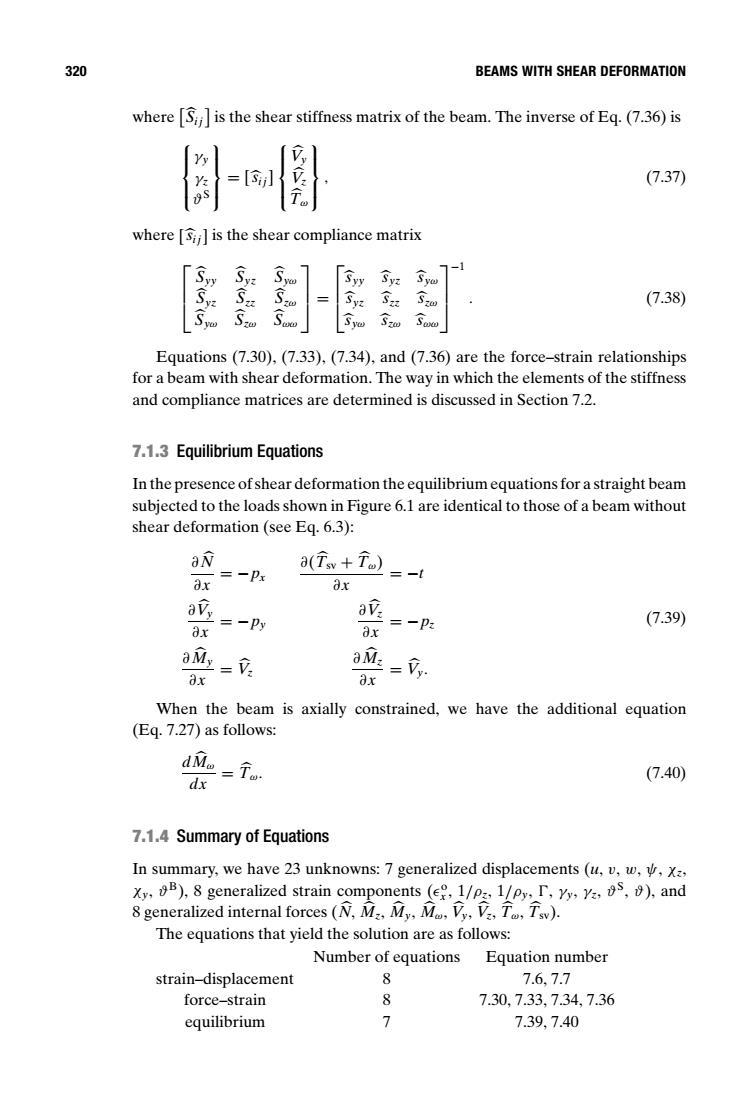正在加载图片...

320 BEAMS WITH SHEAR DEFORMATION where [S]is the shear stiffness matrix of the beam.The inverse of Eq.(7.36)is (7.37) where [;is the shear compliance matrix (7.38) Syo y Equations (7.30),(7.33),(7.34),and (7.36)are the force-strain relationships for a beam with shear deformation.The way in which the elements of the stiffness and compliance matrices are determined is discussed in Section 7.2. 7.1.3 Equilibrium Equations In the presence of shear deformation the equilibrium equations for a straight beam subjected to the loads shown in Figure 6.1 are identical to those of a beam without shear deformation (see Eq.6.3): aN a(Tsv+T.) =- 8x ax a av. =-Py =-Pa (7.39) ax ax aM=立 ax aM:=Vy 0x When the beam is axially constrained,we have the additional equation (Eq.7.27)as follows: dMo =To. (7.40) dx 7.1.4 Summary of Equations In summary,we have 23 unknowns:7 generalized displacements(u,v,w,v,xz, Xy,),8 generalized strain components (e,1/p:,1/p,r,ry,y,,).and 8 generalized internal forces (N,M:,My,M.V,V:,T,Tsv). The equations that yield the solution are as follows: Number of equations Equation number strain-displacement 8 7.6.7.7 force-strain 8 7.30,7.33,7.34,7.36 equilibrium 7 7.39,7.40320 BEAMS WITH SHEAR DEFORMATION where " Si j# is the shear stiffness matrix of the beam. The inverse of Eq. (7.36) is γy γz ϑS = [si j] V y V z T ω , (7.37) where [si j] is the shear compliance matrix Syy Syz Syω Syz Szz Szω Syω Szω Sωω = syy syz syω syz szz szω syω szω sωω −1 . (7.38) Equations (7.30), (7.33), (7.34), and (7.36) are the force–strain relationships for a beam with shear deformation. The way in which the elements of the stiffness and compliance matrices are determined is discussed in Section 7.2. 7.1.3 Equilibrium Equations In the presence of shear deformation the equilibrium equations for a straight beam subjected to the loads shown in Figure 6.1 are identical to those of a beam without shear deformation (see Eq. 6.3): ∂N ∂x = −px ∂(T sv + T ω) ∂x = −t ∂V y ∂x = −py ∂V z ∂x = −pz ∂My ∂x = V z ∂Mz ∂x = V y. (7.39) When the beam is axially constrained, we have the additional equation (Eq. 7.27) as follows: dMω dx = T ω. (7.40) 7.1.4 Summary of Equations In summary, we have 23 unknowns: 7 generalized displacements (u, v, w, ψ, χz, χy, ϑB), 8 generalized strain components (o x , 1/ρz, 1/ρy,
, γy, γz, ϑS, ϑ), and 8 generalized internal forces (N, Mz, My, Mω, V y, V z, T ω, T sv). The equations that yield the solution are as follows: Number of equations Equation number strain–displacement 8 7.6, 7.7 force–strain 8 7.30, 7.33, 7.34, 7.36 equilibrium 7 7.39, 7.40